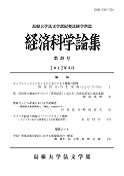島根大学法文学部
ISSN:0387-7310

ダウンロード数 : ? 件
この文献の参照には次のURLをご利用ください : https://ir.lib.shimane-u.ac.jp/2176
経済科学論集 26
2000-03-31 発行
1970年代半ばからの合計出生率低下 : コーホート出生率によるシミュレーション分析
Decline in Total Fertility Rate since 1970's in Japan : Analysis via Simulations by the Cohort Fertility
廣嶋 清志
ファイル
内容記述(抄録等)
Since the fertility rate declined more sharply in most recent years from 1995 to 1998 than before, first, we attempted the projection of the agespecific fertility rates for cohorts that relate to the period fertility rates in recent years using the age-specific fertility rates by calender year.
Next we conducted the simulations to decompose the decline in total fertility rate since 1970 by the effects of declining the level of life-time fertility and the delay in childbearing of the cohorts relating to the period fertility. These simulations clarified the amount and the years of birth of cohorts that contributed to declining period total fertility rate and the delay in age at childbearing year by year. These results will not be obtained by Ryder Indeces which only demonstrate the amount of quantum effect and tempo effect of all cohorts combined relating to the particular period fertility rates.
The results we obtained are first, that the decline in the TFR in the earlier years of 1970's is accounted for by 48% by the decline in cohort life-time fertility of those cohorts born in 1943 to 1949 including baby boomer whose fertility was not lower than that of their successor. This shows that so-called Easterlin Effect did not exist and that the period effect accompanied by the Oil Crisis and the sudden emergence of public awareness to environmental issues may have started the fertility decline.
Secondly, the delay in age at childbearing of birth cohorts from 1949-50 accounts for 35 percent of the decline in period total fertility rates afer 1975. This percentage became less reaching to 20 percent for the later 1990's.
Thirdly, the lowering effect of life-time fertility level became more and more for later period, which means the recovery in TFR in the near future by the cease in the delay of childbearing will be very small. This finding is different from our previous work.
Next we conducted the simulations to decompose the decline in total fertility rate since 1970 by the effects of declining the level of life-time fertility and the delay in childbearing of the cohorts relating to the period fertility. These simulations clarified the amount and the years of birth of cohorts that contributed to declining period total fertility rate and the delay in age at childbearing year by year. These results will not be obtained by Ryder Indeces which only demonstrate the amount of quantum effect and tempo effect of all cohorts combined relating to the particular period fertility rates.
The results we obtained are first, that the decline in the TFR in the earlier years of 1970's is accounted for by 48% by the decline in cohort life-time fertility of those cohorts born in 1943 to 1949 including baby boomer whose fertility was not lower than that of their successor. This shows that so-called Easterlin Effect did not exist and that the period effect accompanied by the Oil Crisis and the sudden emergence of public awareness to environmental issues may have started the fertility decline.
Secondly, the delay in age at childbearing of birth cohorts from 1949-50 accounts for 35 percent of the decline in period total fertility rates afer 1975. This percentage became less reaching to 20 percent for the later 1990's.
Thirdly, the lowering effect of life-time fertility level became more and more for later period, which means the recovery in TFR in the near future by the cease in the delay of childbearing will be very small. This finding is different from our previous work.
Other Article
